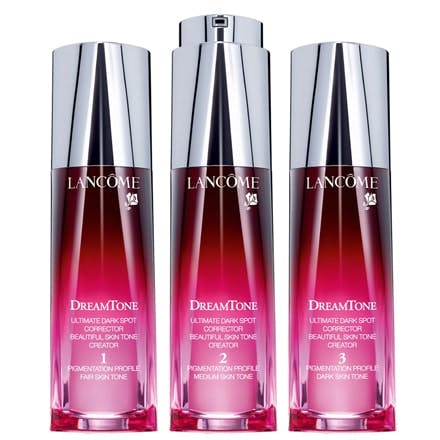Lancome DreamTone Launch

We beauty writers get quite excited when something launches, and it’s actually different. Beauty is so cyclical you see – every year it’s similar products from all the brands, and is, on the whole, quite predictable.
So, Lancome’s DreamTone launch is like a breath of fresh air. Yes, it’s another dark spot/hyperpigmentation correcting product (and there have been LOADS of these recently), but it has a USP! DreamTone comes in three formulas – 1,2 and 3 – each one suited to a different skintone. Which makes sense, no?
So, if you have fair skin, you’re a 1, and so on. Now, this product comes with some science-heavy literature, which, let’s face it, we’re really not going to digest in a blog post. So, I will try and keep it as simple as I can. The skin’s ‘tone’ describes its colour and the evenness of that colour. Your skin colour is a product of three separate chorophores: melanin, carotenoids and haemoglobin.
The ratio of these colour-creating molecules is determined by the genes we inherit and varies across the world. In the past, assessment of skin colour was crude with fewer than half a dozen colour types, based on race and geography but over the years, L’Oreal has developed some fancy new tools – chromasphere and chromameter being a few of them – to accurately quantify skin colour in all its complexity. You can see where this is going, I hope?
So, extensive studies across 19 countries, involving over 10,000 women identified no less than 64 different skin shades. This work informed the development of a portable chart
now used by dermatologists worldwide to definitively record skin hue. Having established the true extent of colour, L’Oreal was then able to characterise three broad pigmentation profiles – fair, medium, and dark.
So, that’s the first bit. Now to a Dr. Françoise Bernerd, and her research. To break it down very quickly, she basically uncovered new evidence that claims our pigmentation issues in our skin do not come from the epidermis – the skin’s top layer – but the dermis – much deeper down, and are, therefore, all very different. So, DreamTone works deeper down, on the differences in the skintone types, which is why you need the skintone specific formula.
It sounds complex, and I guess it is, but it is essentially just choosing the right serum for your skintone, so it can address the pigmentation issues you have – because they will differ depending on your skintone.
The core active ingredients in serums 1,2 and 3 are HPPA (Hydroxyphenoxy Propionic Acid) which is a derivative of hydroquinone. The hydroxy acid part of this ingredient
provides an exfoliating benefit, Pro-Xylane, a derivative based on xylose sugar which improves the quality and strengthens the dermal-epidermal junction. It helps reduce the hyperpigmentation seen in the epidermis via improvements in the upper dermis. Finally, Skinasensyl, which is a tetrapeptide which has skin soothing benefits.
And then each serum has its own target-specific ingredients. So, type 1 helps address vascular changes and combat resulting increases in the redness which is typically seen in this skin type’s pigmentation profile. The active ingredient is Micro Seaweed Extract. Type 2 helps fight against a sallowing of the skin which is typical of this pigmentation profile; the active ingredient is Maitake Extract. And then type 3 which targets blemish marks which are typical of this pigmentation profile. The active ingredient here is a Salycilic Acid Derivative.
The serums also contain non-tinted light-diffusing agents for instant radiation. The only way to tell if all of this science works is to try the serum, but results take around eight weeks at least to be seen, so there is nothing I can tell you now.
If you want to try DreamTone for yourself, it is available from today in Fraser’s, Glasgow, and then on sale nationwide from September 1, priced £69 for £40. Visit lancome.co.uk for more info.

